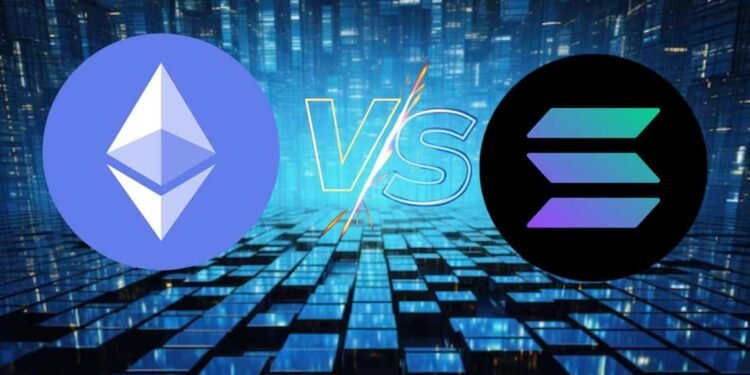Graphite Token: A New Player in the Blockchain Arena
With the evolution of the cryptocurrency landscape, key contenders for blockchain supremacy include Ethereum, Solana, and the rising star, Graphite Token. While Ethereum has held a dominant position for some time, Solana has garnered attention recently for its rapid transaction speeds. On the other hand, Graphite Token is offering a fresh perspective and innovation to the industry. This piece delves into the potential of these platforms and examines which one may emerge as the leader by 2025.
Introducing Graphite Token: Revolutionizing Blockchain Technology
Stepping into the blockchain domain, Graphite Token (@G) is supported by Graphite Layer 1 (L1), an innovative blockchain aiming to enhance cryptocurrency transaction simplicity, speed, and user incentives. Can this newcomer match Ethereum’s remarkable growth of 4,000%?
Unraveling exceptional gains in the crypto market involves identifying nascent projects before they become mainstream. The surge experienced by early backers of groundbreaking initiatives is evident from historical data:
- Solana started at $0.04 and peaked around $300, marking an incredible increase of +7,500%.
- Ethereum debuted below $1 and surged to around $4,000, showcasing an astounding +400,000% return.
The core driver behind this phenomenal growth lies in usability; as these blockchains’ applications expand, so does the value of their associated tokens. However, Ethereum and Solana are encountering escalating challenges in their ecosystem.
Challenges Confronting Ethereum and Solana
Despite their successes, Ethereum and Solana are facing challenges such as escalating fees, operational intricacies, regulatory uncertainties, and reliability issues. Solana has grappled with network failures, while Ethereum witnessed a decline in its burn rate in 2024.
User dissatisfaction with fluctuating gas fees, inconsistent transaction speeds, and service dependability implies a diminishing stronghold of these established platforms.
Unique Value Proposition of Graphite
Graphite distinguishes itself as a promising solution by addressing longstanding issues of older blockchains through various innovative features:
Income for Entry-Point Nodes: Uniquely, Graphite allows entry-point nodes to receive 50% of transaction fees, fostering incentivized engagement that empowers community contributors.
Trust-Based Interactions: Introducing a Trust Score system enhances transparency while preserving user anonymity, fostering interactions built on trust.
Affordable Fees, Swift Transactions, and Scalability: By leveraging the PoA Polymer 2.0 Algorithm, Graphite minimizes operational expenses, processing up to 1,400 transactions per second with sub-10-second confirmation times, effectively balancing speed, cost, and reliability.
- Robust Security Measures: Implementing a one user-one account policy aids in fraud prevention, while the option for KYC verification, supported by zero-knowledge proofs (ZKP), ensures compliance without compromising user privacy.
A Potentially Lucrative Investment Opportunity?
Graphite’s blend of security, transparency, scalability, and affordability positions it as an enticing option for developers and users. With its pragmatic features and early adoption prospects, Graphite emerges as a project worth monitoring closely.
Investors seeking early engagement have the chance to participate in a blockchain tailored for long-term sustainability. While the substantial 4,000% growth remains to be seen, the foundational aspects of Graphite hint at a promising trajectory.
Insights into Ethereum and Solana’s Ecosystems
Ethereum functions as a leading Proof-of-Stake blockchain, facilitating smart contracts and decentralized applications (dApps). It has significantly contributed to decentralized finance (DeFi) development and boasts a vast ecosystem. Through ERC-20 tokens, Ethereum has revolutionized governance and utility in the blockchain sphere, utilizing ETH for transaction gas fees. Since its inception, Ethereum has transitioned to a Proof-of-Stake model with notable upgrades enhancing efficiency.
In contrast, Solana sets itself apart with a scalable architecture, empowering dApps akin to Ethereum and Cardano while prioritizing rapid transactions across multiple programming languages. Its native token, SOL, streamlines transactions and incentivizes participants, bolstering the ecosystem’s vitality without relying on sharding or second-layer solutions for scalability.
In Conclusion
While Ethereum (ETH) and Solana (SOL) have historically led the blockchain realm, emerging challenges hint at limitations to their growth potential. Conversely, Graphite Token (@G) and its innovative Graphite L1 blockchain aim to redefine cryptocurrency simplicity, speed, and rewards. By combatting issues like high fees and reliability concerns, and establishing a strong security framework, Graphite endeavors to set new standards in blockchain technology. For early adopters, an opportunity to engage with this forward-looking project may yield substantial benefits as it positions itself for future expansion and widespread adoption.








